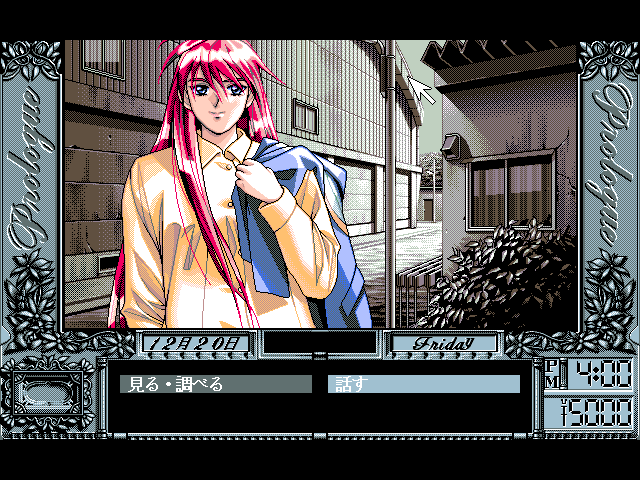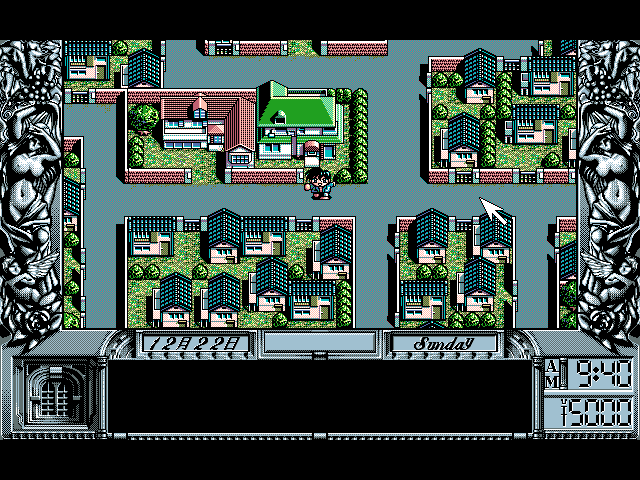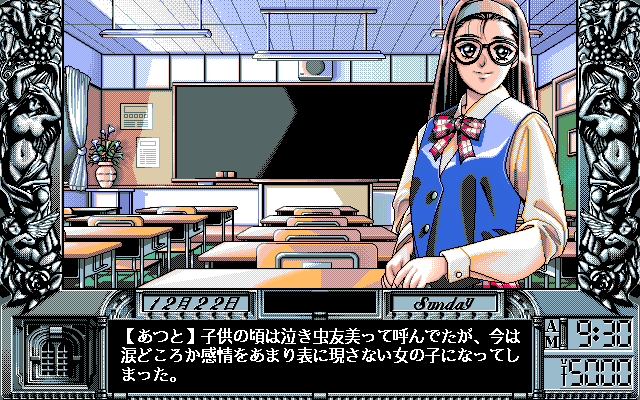Retro Replay Review
Gameplay
At its core, Dōkyūsei 2 plays like a classic adventure title with a strong focus on interactive storytelling. Players explore various locations around the city, examine objects, and initiate conversations with classmates, teachers, and shopkeepers. Every action you take—whether it’s reading a poster at the station or chatting up a friend in the hallway—advances the in-game clock by roughly 20–30 minutes, forcing you to plan your days carefully.
(HEY YOU!! We hope you enjoy! We try not to run ads. So basically, this is a very expensive hobby running this site. Please consider joining us for updates, forums, and more. Network w/ us to make some cash or friends while retro gaming, and you can win some free retro games for posting. Okay, carry on 👍)
The city map serves as your hub for all activities. You can visit the mall, the library, parks, and even schedule dinner dates at specific times. Making appointments is crucial: if you miss a slot, you’ll have to wait an entire day before you can try again, adding a layer of strategic time management to the romance. This mechanic keeps your calendar full and your heart racing as you juggle studies, part-time work, and budding relationships.
Decisions are the lifeblood of Dōkyūsei 2. Branching story paths hinge on your dialogue choices and punctuality. Chatting about the right topics, bringing small gifts, or simply arriving on time can dramatically alter each heroine’s feelings toward you. With fifteen distinct female classmates to romance, the game offers immense replay value as you chase different storylines and strive for the coveted “happy ending” with each character.
The interface is simple but effective. Menus let you check your schedule, view relationship status, and choose destinations with ease. Text is displayed clearly, and character portraits accompany dialogue, making it easy to keep track of who’s talking. Though there’s no voice acting, the well-written script and expressive art bring each interaction to life, ensuring the pacing remains engaging without feeling rushed.
Graphics
Dōkyūsei 2’s visuals epitomize mid-90s Japanese PC-engine artistry. Backgrounds are hand-painted in vibrant but slightly muted hues, conjuring a nostalgic high-school setting that’s both inviting and believable. While the resolution feels low by modern standards, each environment—from the bustling festival grounds to the quiet school rooftop—boasts enough detail to draw you in.
Character portraits are where the game truly shines. Each heroine sports unique hairstyles, outfits, and facial expressions that change dynamically during key story moments. Event CGs (special full-screen illustrations unlocked after important decisions) are colorful and emotive, capturing the moment you finally connect with a chosen classmate. These images remain a memorable highlight for longtime fans.
The limited color palette can make some scenes appear flat or repetitive, especially during overcast weather or nighttime sequences. However, careful use of shading and line work ensures characters stand out crisply against the backgrounds. Transitions between scenes are smooth, and load times (on original hardware or via modern emulation) are minimal, maintaining the game’s narrative flow.
UI elements—such as text boxes, choice prompts, and status screens—use clean, bold fonts with intuitive iconography. The overall design feels cohesive, capturing both the innocence of first love and the subtle excitement of a teenage romance adventure. Even decades after release, the graphics possess a timeless charm that appeals to retro fans and newcomers alike.
Story
You step into the shoes of Ryunosuke, a third-year student at 88 High School whose mother passed away when he was young and whose archaeologist father is often away on distant digs. With academic pressures mounting alongside the typical trials of adolescence, your main quest is to navigate the complex world of teenage romance. Fifteen classmates stand ready for interaction, each with distinct personalities—from the studious bookworm to the vivacious athlete.
The narrative structure is entirely choice-driven. Whether you decide to invite a shy girl to the library or surprise a more outgoing classmate with a late-night call, every decision leads to different events. Dialogue options tackle a range of topics: hobbies, dreams, family life, and more. These conversational threads impact affinity levels, steering the story toward either a heartfelt confession or an awkward rejection.
Character development is surprisingly deep for a game of this era. Each heroine carries her own backstory and emotional baggage—some grapple with family issues, others face peer pressure or self-confidence struggles. As Ryunosuke, you have the opportunity to listen, console, and grow alongside them. The pacing allows for slice-of-life moments (festival dates, study sessions, summer vacations) that enrich the bond between characters.
Multiple endings ensure that no two playthroughs feel identical. Achieving a “good” conclusion with one heroine may require meticulous scheduling, while missing a crucial encounter can lead to bittersweet farewells. These branching outcomes invite you to replay the game, experiment with different strategies, and uncover all the hidden storylines laid out by the developers.
Overall Experience
Dōkyūsei 2 remains a landmark in the “love adventure” genre, offering a pure and unfiltered look at high-school romance. Its blend of time management, conversational depth, and branching narratives creates an immersive atmosphere that few modern dating sims replicate with the same old-school charm. You’ll find yourself eagerly checking the in-game clock and meticulously planning your next move, never quite sure which choice will unlock a key emotional moment.
For those with an appetite for multiple endings and relationship simulations, the game is a treasure trove. Each successful route can take 5–10 hours, and with fifteen distinct characters to pursue, you could invest well over 100 hours exploring every path. The sense of accomplishment when you finally reach a happy ending after numerous failed attempts is deeply rewarding.
While the graphics and user interface feel dated today, they imbue the experience with a nostalgic warmth. The engaging writing, memorable character moments, and expressive event CGs compensate for any technical limitations. Players who appreciate story-driven titles will find themselves captivated by Ryunosuke’s world and the emotional highs and lows that come with each relationship.
Overall, Dōkyūsei 2 stands the test of time as a foundational dating-simulation classic. It’s ideally suited for retro gaming enthusiasts, romance aficionados, and anyone curious about the genre’s early milestones. If you’re looking for a thoughtful, choice-driven love story packed with heartfelt moments and replayability, this 90s gem deserves a spot in your collection.
 Retro Replay Retro Replay gaming reviews, news, emulation, geek stuff and more!
Retro Replay Retro Replay gaming reviews, news, emulation, geek stuff and more!









Reviews
There are no reviews yet.